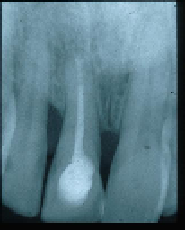Biomedical Engineering Reference
In-Depth Information
ray, and three questions regarding subjective symptoms were put to patients: 1. Have you
had any persistent symptoms? 2. Do you know which tooth was treated? 3. Can you feel
any symptoms at the tooth apex?
In 13 of the 17 treated patients the diagnosis was chronic perapical osteitis (c p o). These
were treated with retrograde root filling (rf) therapy. Three patients suffered from trauma or
chronic perapical destruction, and these patients were treated with orthograde therapy. Out
of 17 patients (22 teeth) treated, 16 patients (21 teeth) were examined with follow-up x-ray
after treatment and also after two years or more. The additional patient was asked about
symptoms. The results of both the clinical examination and the subjective symptoms were
graded into different groups related to the success of the therapy. The results of the 2-year
and the 5-year study are shown in Table 14.
1 Complete
healing
2 Incomplete
healing
3 Uncertain
4 Failure
2-year 5-year 2-year 5-year 2 year 5-year 2-year 5-year
Nos. of teeth 18 14 3 2 0 0 1 0
Percentage 82 87 14 13 0 0 4 0
Table 14. Summary of the results (Score 1 and 2 considered successful, score 3 and 4 failure)
Figures 9-10 show examples of the X-ray examination of orthograde and retrograde
treatments.
Fig. 9. Tooth 21 (patient14) a) condensing with a Gutta-percha pointer, b) just after treatment
and c) at two year control
Fig. 10. Tooth 21 (patient 9) at treatment (left) and at two year control (middle) and at 5 year
control (right)
In summary 21 out of 22 treated teeth have acceptable results being either symptom free or
judged healed after clinical examination. The single failure can probably not be attributed to
















